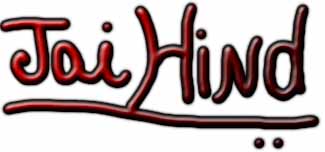 |
 |
| Back to Home |
|
|
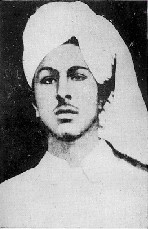 |
| The aim of life is no more to control the mind, but to develop it harmoniously; not to achieve salvation here after, but to make the best use of it here below; and not to realise truth, beauty and good only in contemplation, but also in the actual experience of daily life; social progress depends not upon the ennoblement of the few but on the enrichment of democracy; universal brotherhood can be achieved only when there is an equality of opportunity - of opportunity in the social, political and individual life." — from Bhagat Singh's prison diary |
| At the age of 23, if anyone was smiling just before he was being hanged to death, it was Shaheed Bhagat Singh. He was born September 27, 1907 in the village Banga of Layalpur to Mata Vidyavati and Sardar Kishan Singh. His uncle, Sardar Ajit Singh, as well as his father, were great freedom fighters, so Bhagat Singh grew up in a patriotic atmosphere. Ajit Singh established the Indian Patriots' Association, along with Syed Haidar Raza, to organize the peasants against the Chenab Canal Colony Bill. He also established the secret organization, the Bharat Mata Society. | |||||||||||||||||||||||||||||||||||||||||||||||||||||||
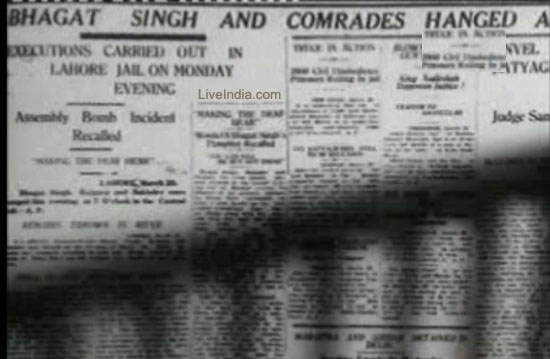
In search of revolutionary groups and ideas, he met Sukhdev and Rajguru. Bhagat Singh, along with the help of Chandrashekhar Azad, formed the Hindustan Socialist Republican Army (HSRA). The aim of this Indian revolutionary movement was now defined as not only to make India independent, but also to create "a socialist India." During the Simon Commission, Sher-e-Punjab Lala Lajpat Rai was wounded and died later. To avenge his death, Bhagat Singh and Rajguru killed Mr. Saunders (one of the deputy officers in connection with the Simon Commission). |
|||||||||||||||||||||||||||||||||||||||||||||||||||||||
|
He and his friends wanted to be shot dead, since they were termed as prisoners of war. Their request was not fulfilled, and on March 23, 1931, Bhagat Singh, Shivram Rajguru, and Sukhdev were hanged to death. This man's only mission in life was to see his country free from British rule. He did his best and when he was being led to the gallows, he was satisfied that he had lived up to his principles, irrespective of the consequences. The only thing that made him sad was that he couldn't do more for his country. Bhagat Singh, September 27, 1907 – March 23, 1931) was an Indian freedom fighter, considered to be one of the most influential revolutionaries of the Indian independence movement. He is often referred to as Shaheed Bhagat Singh (the word shaheed means "martyr"). Born to a family which had earlier been involved in revolutionary activities against the British Raj in India, Singh, as a teenager, had studied European revolutionary movements and was attracted to anarchism and communism. He became involved in numerous revolutionary organizations. He quickly rose through the ranks of the Hindustan Republican Association (HRA) and became one of its leaders, converting it to the Hindustan Socialist Republican Association (HSRA). Singh gained support when he underwent a 63-day fast in jail, demanding equal rights for Indian and British political prisoners. He was hanged for shooting a police officer in response to the killing of veteran freedom fighter Lala Lajpat Rai. His legacy prompted youth in India to begin fighting for Indian independence and also increased the rise of socialism in India Bhagat Singh was born into a Jatt Sandhu family to Sardar Kishan Singh Sandhu and Vidyavati in the Khatkar Kalan village near Banga in the Lyallpur district of Punjab. Singh's given name of Bhagat means "devotee". He came from a patriotic Sikh family, some of whom had participated in movements supporting the independence of India and others who had served in Maharaja Ranjit Singh's army. His grandfather, Arjun Singh, was a follower of Swami Dayananda Saraswati's Hindu reformist movement, Arya Samaj, which would carry a heavy influence on Singh. His uncles, Ajit Singh and Swaran Singh, as well as his father were members of the Ghadar Party, led by Kartar Singh Sarabha Grewal and Har Dayal. Ajit Singh was forced to flee to Persia because of pending cases against him while Swaran Singh was hanged on December 19, 1927 for his involvement in the Kakori train robbery of 1925. Unlike many Sikhs his age, Singh did not attend Khalsa High School in Lahore, because his grandfather did not approve of the school officials' loyalism to the British authorities. Instead, his father enrolled him in Dayanand Anglo Vedic High School, an Arya Samajist school. At age 13, Singh began to follow Mahatma Gandhi's Non-Cooperation Movement. At this point he had openly defied the British and had followed Gandhi's wishes by burning his government-school books and any British-imported clothing. Following Gandhi's withdrawal of the movement after the violent murders of policemen by villagers from Chauri Chaura, Uttar Pradesh, Singh, disgruntled with Gandhi's nonviolence action, joined the Young Revolutionary Movement and began advocating a violent movement against the British. In 1923, Bhagat famously won an essay competition set by the Punjab Hindi Sahitya Sammelan. This grabbed the attention of members of the Punjab Hindi Sahitya Sammelan including its General Secretary Professor Bhim Sen Vidyalankar. At this age, he quoted famous Punjabi literature and discussed the Problems of the Punjab. He read a lot of poetry and literature which was written by Punjabi writers and his favourite poet was Allama Iqbal from Sialkot. In his teenage years, Bhagat Singh started studying at the National College in Lahore,[12] but ran away from home to escape early marriage, and became a member of the organization Naujawan Bharat Sabha ("Youth Society of India").[2] In the Naujawan Bharat Sabha, Singh and his fellow revolutionaries grew popular amongst the youth. He also joined the Hindustan Republican Association at the request of Professor Vidyalankar, which was then headed by Ram Prasad Bismil and Ashfaqulla Khan.[citation needed] It is believed that he had knowledge of the Kakori train robbery. He wrote for and edited Urdu and Punjabi newspapers published from Amritsar. In September 1928, a meeting of various revolutionaries from across India was called at Delhi under the banner of the Kirti Kissan Party. Bhagat Singh was the secretary of the meet. His later revolutionary activities were carried out as a leader of this association. The capture and hanging of the main HRA Leaders also allowed him to be quickly promoted to higher ranks in the party, along with his fellow revolutionary Sukhdev Thapar. Lala Lajpat Rai's death
and the Saunders murder
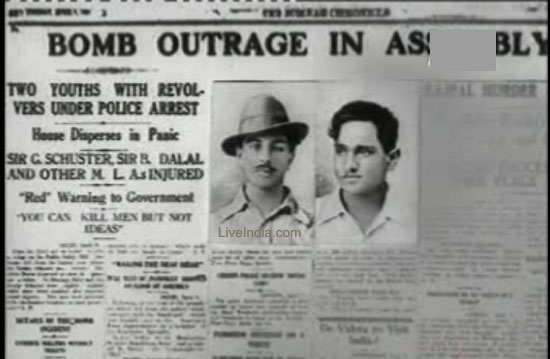 In the face of actions by the revolutionaries, the British government enacted the Defence of India Act to give more power to the police. The purpose of the Act was to combat revolutionaries like Bhagat Singh. The Act was defeated in the council by one vote. However, the Act was then passed under the ordinance that claimed that it was in the best interest of the public. In response to this act, the Hindustan Socialist Republican Association planned to explode a bomb in the Central Legislative Assembly where the ordinance was going to be passed. Originally, Chandrashekhar Azad, another prominent leader of the revolutionary movement attempted to stop Bhagat Singh from carrying out the bombing. However, the remainder of the party forced him to succumb to Singh's wishes. It was decided that Bhagat Singh and Batukeshwar Dutt, another revolutionary, would throw the bomb in the assembly. On April 8, 1929, Singh and Dutt threw a bomb onto the corridors of the assembly and shouted "Inquilab Zindabad!" ("Long Live the Revolution!").[15] This was followed by a shower of leaflets stating that it takes a loud voice to make the deaf hear.[16] The bomb neither killed nor injured anyone; Singh and Dutt claimed that this was deliberate on their part, a claim substantiated both by British forensics investigators who found that the bomb was not powerful enough to cause injury, and by the fact that the bomb was thrown away from people. Singh and Dutt gave themselves up for arrest after the bomb.[citation needed] He and Dutt were sentenced to 'Transportation for Life' for the bombing on June 12, 1929. Last wish
Death
While in prison, Bhagat Singh and two others had written a letter to the Viceroy asking him to treat them as prisoners of war and hence to execute them by firing squad and not by hanging. Prannath Mehta, Bhagat Singh's friend, visited him in the jail on March 20, four days before his execution, with a draft letter for clemency, but he declined to sign it. 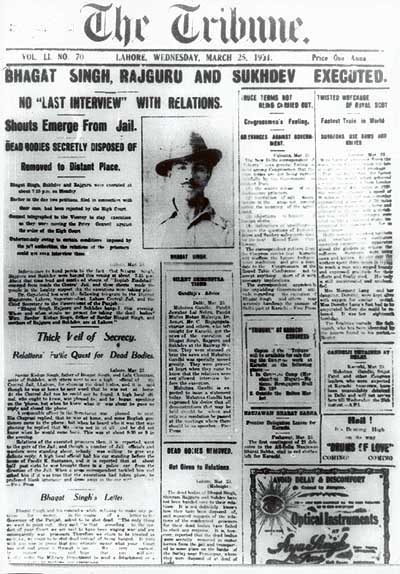
|
|||||||||||||||||||||||||||||||||||||||||||||||||||||||
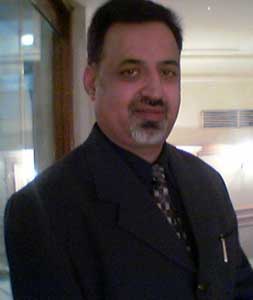
Welcome to Rajesh Chopra's Guest Book and comments Please |
|||||||||||||||||||||||||||||||||||||||||||||||||||||||
 |
| Back to Home |
 |
 |
 |
 |